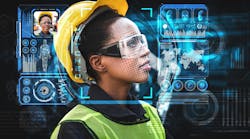Access control systems of yore were relatively simple technologies. An on-premises control server configured groups and users, who were then assigned a physical token, typically in the form of a key card. The system then centrally controlled access to all exterior doors along with a handful of highly sensitive areas, such as data centers, offices, conference rooms, and elevators.
In contrast, modern access control platforms are moving beyond the limited capabilities of centralized deployment architecture. New features expand the ease of use and effectiveness of a traditional physical security system. Lower component costs and flexible network connectivity options also enable the deployment of additional access-controlled areas within a building. In fact, modern access control systems offer five advancements that create value for both building owners and occupants.
1. SaaS Architecture
Property owners are finding tremendous value in software as a service (SaaS) applications and services. Not only is a SaaS-based access control system a low-cost option in terms of capital and operating expenditures at scale, but it also eliminates the need to deploy and manage a physical access control server inside a local data center. This requires less data center space and eliminates the need to power and cool any in-house equipment.
SaaS-based access control systems are also incredibly scalable. Property IT departments can manage access to multiple buildings using a single management interface, simplifying system monitoring for companies overseeing several properties. Several SaaS-based platforms offer a smartphone app for users in lieu of a key card. This further eliminates any physical deployment of access control components, simplifying the onboarding and offboarding processes.
2. Microlevel Access Control
Thanks to the lower cost of access control components along with improvements to connectivity options, including standard Ethernet, single-pair Ethernet (SPE), and Wi-Fi, adding door controller locks is easier than ever. The controller locks can secure interior doors, as well as cabinets, closets, and drawers.
3. Biometrics
Biometrics, such as facial, voice, retina, and handprint recognition, are growing in popularity due to their decreasing technology costs and significantly improved accuracy in recent years. In many cases, biometric systems can eliminate the need for physical key cards. This removes the headache of forgotten or lost key cards while introducing touchless door access opportunities, a growing trend in a post COVID-19 world. This does raise privacy concerns, however.
4. Multifactor Authentication
High-security buildings may require additional technologies prior to granting access to an employee, occupant, or contractor. Key cards are easily lost or stolen, leading to unauthorized access risks. To remedy this, owners can implement multifactor authentication. This security model requires the use of a physical token, such as a key card or cellphone, in conjunction with a biometric authentication method to provide added assurance that the person attempting to access a space using a physical token is indeed authorized to use it.
5. Analytics and Integrations
The amount of useful data that can be extracted from modern access control systems is impressive. This information can determine who is accessing what, peak entry and exit times, and the flow of occupant traffic on any given day. Further data analysis can lead to deeper insights and actions, such as the following:
- Baseline normal access behavior at a per-user and per-group level. This information can be used to tighten role-based access policy and to identify potential security threats when access behavior veers significantly from the norm.
- Tie real-time occupancy location data to the HVAC system for more efficient control.
- Match occupancy numbers and location data with air quality and health-related IoT systems to improve the well-being of occupants in congested areas.
ROI Opportunities Abound
Full replacement of a legacy access control system offers return on investment opportunities around every corner. Management simplification, automation, expansion of secure access points, and data-backed controls of HVAC systems to improve occupant health and operating efficiency are only the start of what can be accomplished.
About the Author:
Andrew Froehlich is a contributor to BUILDINGS and Smart Buildings Technology. He is the founder and president of Colorado-based West Gate Networks, which specializes in enterprise network architectures and data center build-outs.
This article originally appeared in Smart Buildings Technology.


